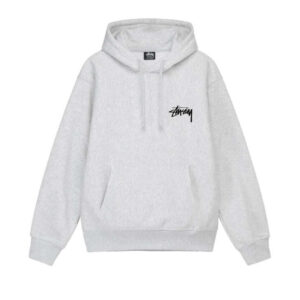
Streetwear isn’t just about what you wear—it’s how you say it. It’s a visual dialect, a coded system of self-expression that speaks to where you’ve been, what you stand for, and the culture you carry on your back. Few pieces embody this language better than the Stüssy hoodie. More than a staple, it’s a statement. Quiet, confident, and deeply fluent in street culture.
Since the early 1980s, Stüssy has been crafting clothes with attitude—not the kind you shout, but the kind you nod to. And at the heart of its wardrobe lies the hoodie: that soft, functional, always-in-rotation item that does more than keep you warm. In Stüssy’s world, a hoodie is a manifesto. A message. A map of where streetwear started and where it’s headed.
The Script That Started It All
To understand the significance of a Stüssy hoodie, you have to start with the logo. That scrawled, hand-drawn script—originally the signature of founder Shawn Stussy on his surfboards—became the visual cornerstone of the brand. When it migrated to tees and hoodies, it instantly felt like something raw, something real. Not corporate. Not polished. Just pure street.
That logo didn’t just brand the clothes—it branded the culture. Seeing it on a hoodie said something without saying anything. You weren’t chasing hype; you were honoring heritage. You weren’t trying too hard; you already got it.
A Hoodie That Speaks Volumes
Unlike designer logos that shout for attention, a Stüssy hoodie speaks in subtleties. It’s the type of piece you wear over and over, not because it’s flashy, but because it feels right. The fit, the cotton, the graphic placement—it all plays into a kind of effortless confidence that streetwear is built on.
In fact, the Stüssy hoodie is a masterclass in minimalist storytelling. Sometimes it’s just the iconic logo across the chest. Sometimes it’s a reimagined graphic inspired by vintage punk flyers, reggae records, or Tokyo club scenes. But it always speaks the same language: culture, community, cool.
Global Dialects, Local Vibes
One of the most fascinating things about Stüssy hoodies is how their message shifts slightly depending on where you wear them. In LA, they’re rooted in surf-skate nostalgia. In New York, they nod to underground hip-hop. In Tokyo, they tap into high-low fashion fusion. In London, they’ve been worn by everyone from grime MCs to fashion editors.
This global fluency is what makes Stüssy hoodies so universally iconic. They adapt to local slang while staying true to the source. Whether layered over baggy denim, paired with tailored trousers, or styled with beat-up sneakers, they always carry that unmistakable Stüssy tone.
The Hoodie as Identity
Wearing a Stüssy hoodie is like speaking in code to the people who get it. It’s less about trends and more about taste. It tells the world that you value history, understand aesthetic nuance, and know the difference between a moment and a movement.
This is why Stüssy has endured when so many brands have burned out. The hoodie isn’t just merchandise—it’s a piece of personal language. It belongs to the wearers who bring it to life. The artists. The skaters. The DJs. The designers. The kids on the fringe who saw themselves in something different and decided to wear it out loud.
Beyond the Hype
In an era where fashion often leans toward the performative, the Stüssy hoodie remains rooted in authenticity. It doesn’t need a drop countdown or celebrity co-sign to be relevant. Its relevance comes from the streets—from the people who’ve been wearing it, remixing it, and living in it for decades.
That’s the true power of streetwear as language: it doesn’t just follow culture, it creates it. And Stüssy, hoodie by hoodie, has been writing its own dictionary since day one.
The Final Word
In the end, a Stüssy hoodie isn’t just an item of clothing. It’s a sentence in the ongoing conversation of style. A wearable piece of history that continues to evolve with every generation that pulls it over their head. It doesn’t yell. It doesn’t beg for attention. It just is.
And in the language of streetwear, sometimes the quietest pieces speak the loudest.